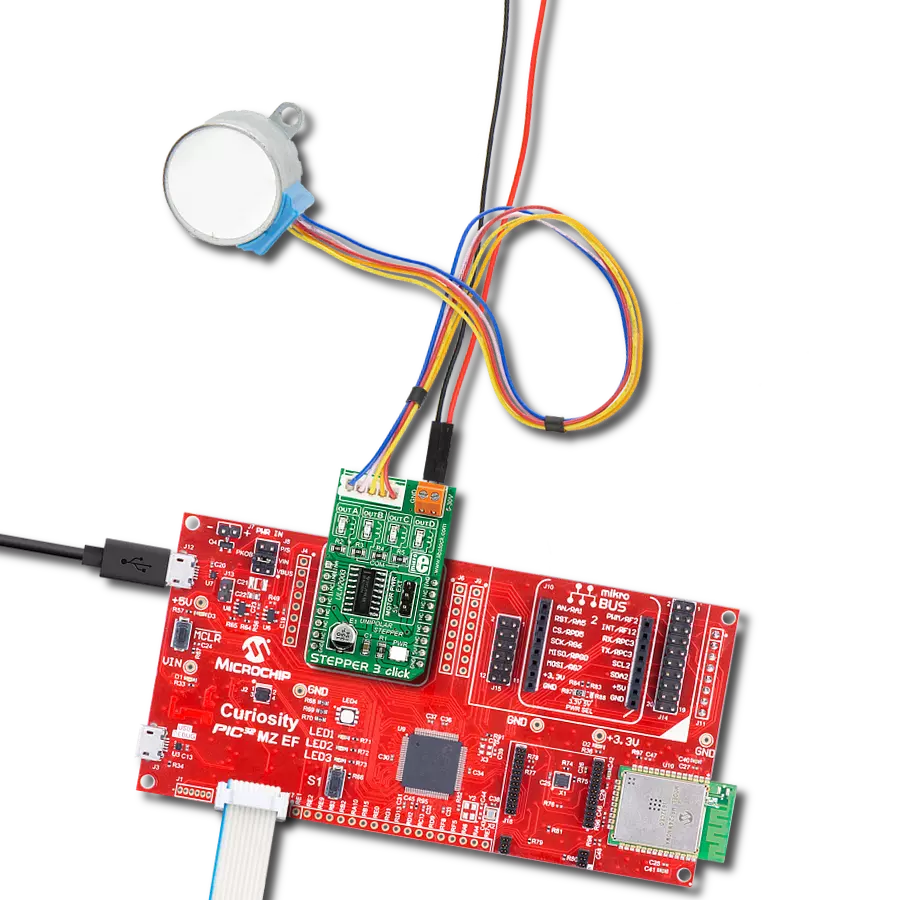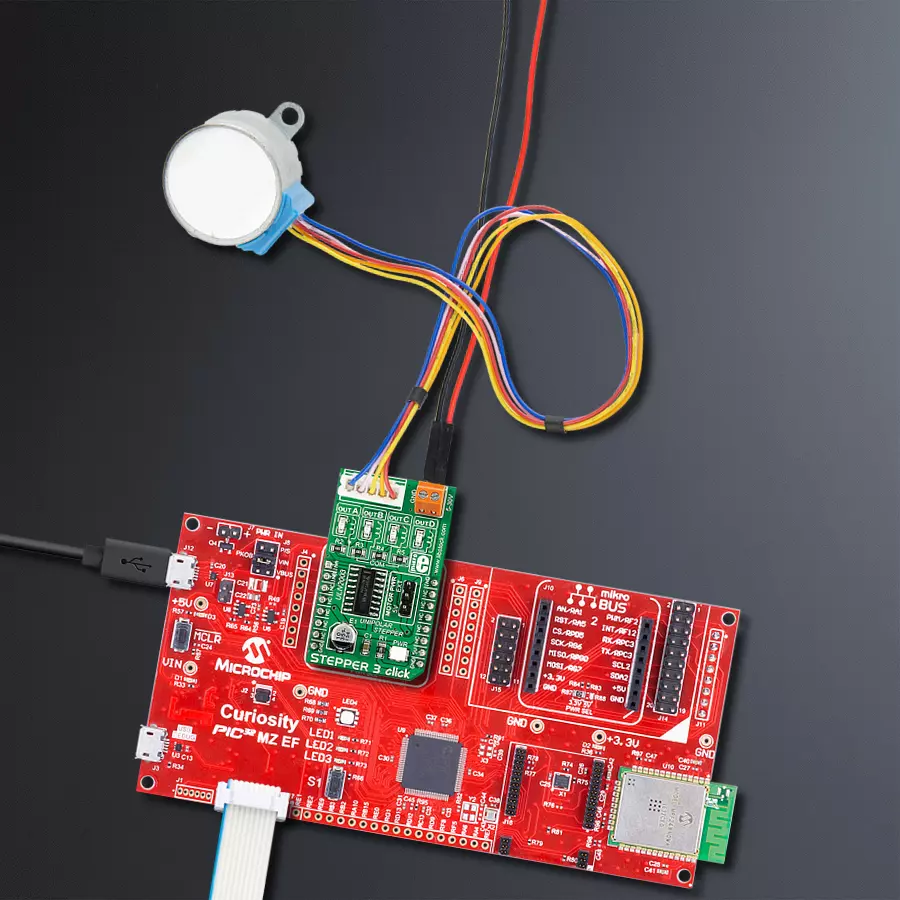High-voltage, high-current Darlington transistor array designed to control the current flow from a supply voltage through the motor coil by activating one of its seven high-power Darlington output stages
A
A
Hardware Overview
How does it work?
Stepper 3 Click is based on the ULN2003A, a high-voltage, high-current Darlington transistor array from Texas Instruments. Motor step progression is performed by alternating the active driver, which sinks the current through the coil connected to the respective driver. The MCU performs the alteration cycle, which controls the driver inputs: a HIGH logic level on the input pin will set the corresponding driver to a LOW logic level, allowing it to sink current. Besides driving a unipolar stepper motor as the primary function, this Click board™ can also be used for driving relays and brushed DC motors
or as the logic buffer for various applications. Combining more than one driver makes it possible to sink more than 500mA. Stepper 3 Click uses four GPIOs to allow the host MCU to control the stepper motor or other mentioned device. Those pins are labeled as INA, INB, INC, and IND. Four output channels from the ULN2203A and a motor power supply are routed to the unpopulated 5-pin header. The motor can be powered over the 5V rail of the mikroBUSTM socket or the external power supply terminal with voltages of 5 – 30V. The selection can be made over the MOTOR PWR jumper. In
addition, the ULN2003As output channels are also routed to the four output LEDs (outA, outB, outC, and outD) for a visual presentation. This Click board™ can be operated only with a 5V logic voltage level. The board must perform appropriate logic voltage level conversion before using MCUs with different logic levels. Also, it comes equipped with a library containing functions and an example code that can be used as a reference for further development.
Features overview
Development board
Curiosity PIC32 MZ EF development board is a fully integrated 32-bit development platform featuring the high-performance PIC32MZ EF Series (PIC32MZ2048EFM) that has a 2MB Flash, 512KB RAM, integrated FPU, Crypto accelerator, and excellent connectivity options. It includes an integrated programmer and debugger, requiring no additional hardware. Users can expand
functionality through MIKROE mikroBUS™ Click™ adapter boards, add Ethernet connectivity with the Microchip PHY daughter board, add WiFi connectivity capability using the Microchip expansions boards, and add audio input and output capability with Microchip audio daughter boards. These boards are fully integrated into PIC32’s powerful software framework, MPLAB Harmony,
which provides a flexible and modular interface to application development a rich set of inter-operable software stacks (TCP-IP, USB), and easy-to-use features. The Curiosity PIC32 MZ EF development board offers expansion capabilities making it an excellent choice for a rapid prototyping board in Connectivity, IOT, and general-purpose applications.
Microcontroller Overview
MCU Card / MCU

Architecture
PIC32
MCU Memory (KB)
2048
Silicon Vendor
Microchip
Pin count
100
RAM (Bytes)
524288
You complete me!
Accessories
The 28BYJ-48 is an adaptable 5VDC stepper motor with a compact design, ideal for various applications. It features four phases, a speed variation ratio of 1/64, and a stride angle of 5.625°/64 steps, allowing precise control. The motor operates at a frequency of 100Hz and has a DC resistance of 50Ω ±7% at 25°C. It boasts an idle in-traction frequency greater than 600Hz and an idle out-traction frequency exceeding 1000Hz, ensuring reliability in different scenarios. With a self-positioning torque and in-traction torque both exceeding 34.3mN.m at 120Hz, the 28BYJ-48 offers robust performance. Its friction torque ranges from 600 to 1200 gf.cm, while the pull-in torque is 300 gf.cm. This motor makes a reliable and efficient choice for your stepper motor needs.
Used MCU Pins
mikroBUS™ mapper
Take a closer look
Click board™ Schematic

Step by step
Project assembly
Track your results in real time
Application Output
1. Application Output - In Debug mode, the 'Application Output' window enables real-time data monitoring, offering direct insight into execution results. Ensure proper data display by configuring the environment correctly using the provided tutorial.

2. UART Terminal - Use the UART Terminal to monitor data transmission via a USB to UART converter, allowing direct communication between the Click board™ and your development system. Configure the baud rate and other serial settings according to your project's requirements to ensure proper functionality. For step-by-step setup instructions, refer to the provided tutorial.

3. Plot Output - The Plot feature offers a powerful way to visualize real-time sensor data, enabling trend analysis, debugging, and comparison of multiple data points. To set it up correctly, follow the provided tutorial, which includes a step-by-step example of using the Plot feature to display Click board™ readings. To use the Plot feature in your code, use the function: plot(*insert_graph_name*, variable_name);. This is a general format, and it is up to the user to replace 'insert_graph_name' with the actual graph name and 'variable_name' with the parameter to be displayed.

Software Support
Library Description
This library contains API for Stepper 3 Click driver.
Key functions:
stepper3_set_step_mode- This function sets the step mode resolution settings in ctx->step_modestepper3_set_direction- This function sets the motor direction to clockwise or counter-clockwise in ctx->directionstepper3_drive_motor- This function drives the motor for the specific number of steps at the selected speed
Open Source
Code example
The complete application code and a ready-to-use project are available through the NECTO Studio Package Manager for direct installation in the NECTO Studio. The application code can also be found on the MIKROE GitHub account.
/*!
* @file main.c
* @brief Stepper 3 Click Example.
*
* # Description
* This example demonstrates the use of the Stepper 3 Click board by driving the
* motor in both directions for a desired number of steps.
*
* The demo application is composed of two sections :
*
* ## Application Init
* Initializes the driver and logger.
*
* ## Application Task
* Drives the motor clockwise for 64 full steps and then counter-clockiwse for 128 half
* steps with 2 seconds delay before changing the direction. All data is being logged on
* the USB UART where you can track the program flow.
*
* @note
* Step Motor 5v [MIKROE-1530] is a fully compatible stepper motor for this Click board:
* https://www.mikroe.com/step-motor-5v
*
* @author Stefan Filipovic
*
*/
#include "board.h"
#include "log.h"
#include "stepper3.h"
static stepper3_t stepper3; /**< Stepper 3 Click driver object. */
static log_t logger; /**< Logger object. */
void application_init ( void )
{
log_cfg_t log_cfg; /**< Logger config object. */
stepper3_cfg_t stepper3_cfg; /**< Click config object. */
/**
* Logger initialization.
* Default baud rate: 115200
* Default log level: LOG_LEVEL_DEBUG
* @note If USB_UART_RX and USB_UART_TX
* are defined as HAL_PIN_NC, you will
* need to define them manually for log to work.
* See @b LOG_MAP_USB_UART macro definition for detailed explanation.
*/
LOG_MAP_USB_UART( log_cfg );
log_init( &logger, &log_cfg );
log_info( &logger, " Application Init " );
// Click initialization.
stepper3_cfg_setup( &stepper3_cfg );
STEPPER3_MAP_MIKROBUS( stepper3_cfg, MIKROBUS_1 );
if ( DIGITAL_OUT_UNSUPPORTED_PIN == stepper3_init( &stepper3, &stepper3_cfg ) )
{
log_error( &logger, " Communication init." );
for ( ; ; );
}
log_info( &logger, " Application Task " );
}
void application_task ( void )
{
log_printf ( &logger, " Move 64 full steps clockwise \r\n\n" );
stepper3_set_step_mode ( &stepper3, STEPPER3_MODE_FULL_STEP );
stepper3_set_direction ( &stepper3, STEPPER3_DIR_CW );
stepper3_drive_motor ( &stepper3, 64, STEPPER3_SPEED_FAST );
Delay_ms ( 1000 );
Delay_ms ( 1000 );
log_printf ( &logger, " Move 128 half steps counter-clockwise \r\n\n" );
stepper3_set_step_mode ( &stepper3, STEPPER3_MODE_HALF_STEP );
stepper3_set_direction ( &stepper3, STEPPER3_DIR_CCW );
stepper3_drive_motor ( &stepper3, 128, STEPPER3_SPEED_VERY_FAST );
Delay_ms ( 1000 );
Delay_ms ( 1000 );
}
int main ( void )
{
/* Do not remove this line or clock might not be set correctly. */
#ifdef PREINIT_SUPPORTED
preinit();
#endif
application_init( );
for ( ; ; )
{
application_task( );
}
return 0;
}
// ------------------------------------------------------------------------ END


































